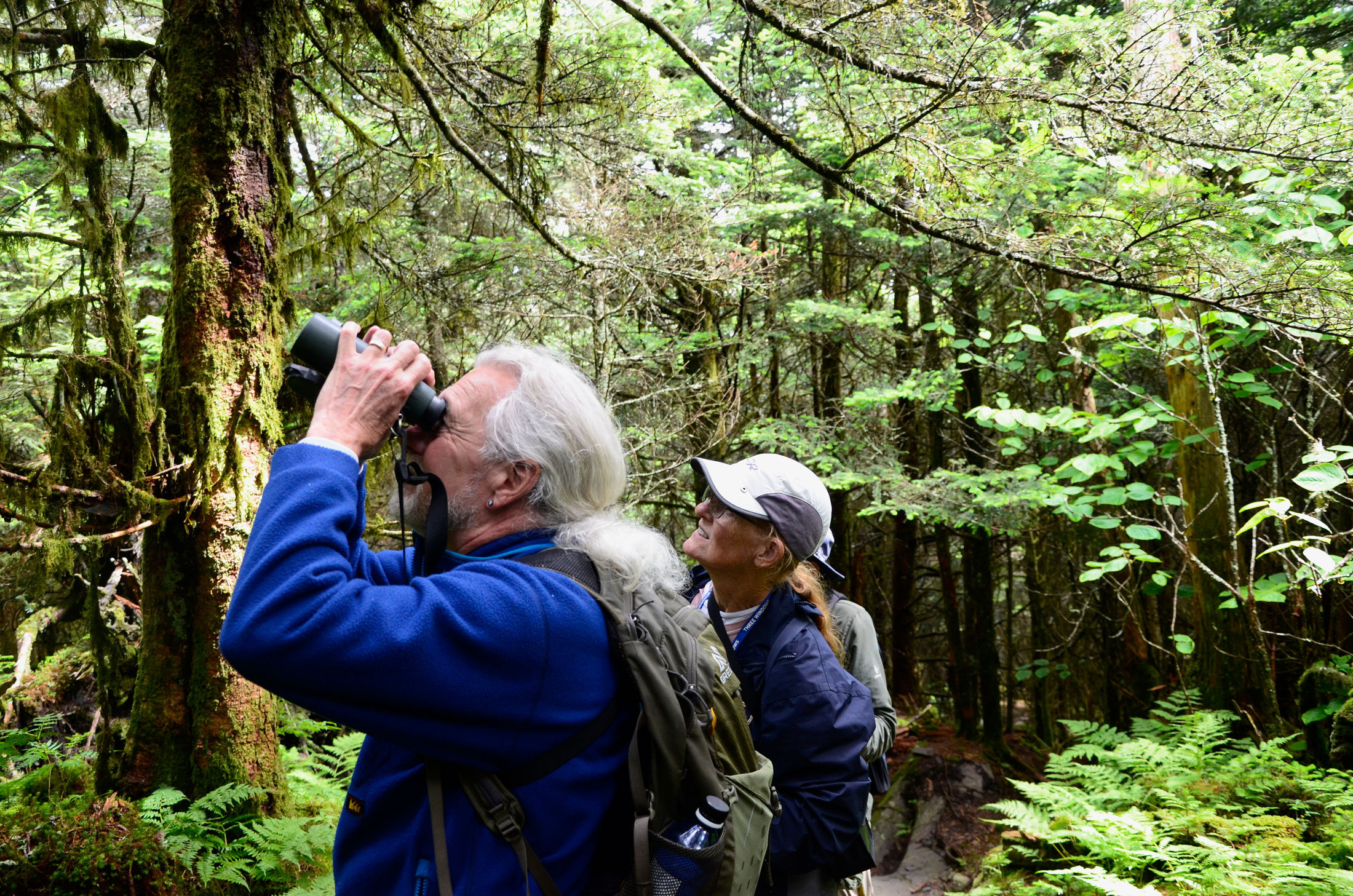
The group has already set out from the Clingmans Dome parking lot when I realize I need to run back to the car once more before embarking on the day’s adventure. I assure the leader, a birder, banjo player, and retired migratory bird biologist named Keith Watson, that there’s no need to wait for me. I’ll catch back up along the planned route, I promise.
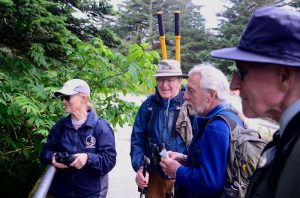
Watson is unflustered. “We’re not in a hurry,” he says. Catching up will be easy.
He’s right. I return to find the group, part of a Branch Out event available exclusively to members of the Smokies Life Park Keepers Program, only about 20 yards up the trail from where I’d left them. They’ve got binoculars pressed to their eyes as they peer into the high-elevation meadow to the left of the trail, a unique habitat that’s a dependable repository of birds found in few other places in the southeastern United States. Mature Fraser fir trees—rare survivors of the ravages of the balsam woolly adelgid, an invasive insect that has wiped out 90 percent of the park’s mature fir trees since its arrival in 1962—tower over an open understory of sochan, angelica, beebalm, mountain-ash, and countless other plants.
This diversity of plants supports a diversity of birds. In less than a quarter mile, Watson has identified at least seven species, ranging from common sights like American crows and American robins to less frequent finds—ruby-throated hummingbird, least flycatcher, golden-crowned kinglet, winter wren, cedar waxwing, dark-eyed junco. I watch as a cedar waxwing perches atop a fir tree, ruffling its feathers in the wind. The details of its blush-colored crest, black mask, and the namesake waxy red marks on its wings are startlingly clear through my loaner binoculars from Watson—“essential” birding equipment, he told me.
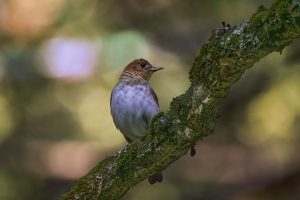
He would know. Watson has been a birder ever since encountering a vibrant Blackburnian warbler at Sharp’s Ridge in Knoxville one auspicious day in the 1970s. The songbird’s flame-orange face and the intricate black-and-white pattern covering the rest of its body drew Watson’s interest. He was “hooked.” Now he birds wherever he goes, and when it comes to the birds of the Smokies, Watson’s knowledge is especially encyclopedic. He knows their calls, their songs, their habits, and the subtle differences between male, female, and juvenile feathering. Still, he doesn’t claim to know it all—“I’m learning something every time I go out,” he says.
I hope to absorb some fraction of Watson’s accumulated knowledge over the course of the day, which begins with a 7:30 a.m. meetup time and is scheduled to run through 3:30 p.m. But we won’t be covering any great distance during those hours—the half-mile walk to Clingmans Dome takes upwards of two hours, stopping to investigate every chirp or trill. Each time, Watson listens, makes his ID, and tries to offer us a glimpse of the feathered singer. He makes soft sounds, onomatopoeically called “spishing,” an imitation of the scold calls some species use to alert nearby birds to a potential threat. Often, birds fly toward the noise, mobbing the intruder and giving their fellow songbirds a chance to escape. Birds, it turns out, are courageous little creatures.
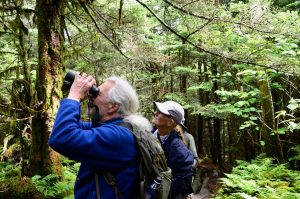
The dome itself is wrapped in fog, the view from the tower obscured but for the treetops covering the nearby slope. A family of juncos flits around the bottom, diving in and out of tree branches and underbrush as they hunt for seeds to eat. We watch them for a while before heading north on the Appalachian Trail. The refreshing smell of spruce and fir fills the air, but we turn around before long. The woods are all but silent. “I have no explanation,” says Watson, turning us southbound. “We should be hearing birds.”
As we walk toward Mount Buckley, the forest is still quieter than Watson was expecting, but it’s far from silent. We hear a black-capped chickadee, winter wren, more golden-crowned kinglets, more juncos. And as we head back toward the parking lot, we hear the unmistakable cascade of notes that marks the presence of a type of thrush called a veery. It has a similar shape to a robin, a white belly, and brown markings. Its song reminds me of a metallic-tinged clarinet trill. This unique bird is capable of singing a duet with itself, Watson tells us—its divided voice box allows it to produce two notes at once. We stop, listen, and catch glimpses of this woodland wonder darting silently around us.
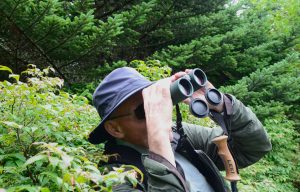
For participant Michael Tenbus, it’s these deep pauses that make birding trips with Watson so special.
“A lot of other people I’ve gone birding with would have said, ‘Oh, that’s a veery,’ and they move on,” said Tenbus. “But he takes the time to show you what the bird looks like. Takes a lot of time to find the bird, and most of the time he does.”
If someone’s never had that experience, said Tenbus, they don’t know what they’re missing.
“Most of all,” said Watson, “I just want to show participants a good time. I want them to have fun, out enjoying the beautiful resources here in the park.”
Led by knowledgeable and experienced guides like Watson, Branch Out events offer a variety of experiences delving into Great Smoky Mountains National Park’s diverse resources year-round. Participation fees help support critical programs within the park. For upcoming events, including searching for salamanders at Sugarlands and witnessing actress Anne Van Curen transform into AT legend Grandma Gatewood in Townsend, visit SmokiesLife.org/events.
Subscribe to get the latest posts sent to your email.
The Great Smokies Welcome Center is located on U.S. 321 in Townsend, TN, 2 miles from the west entrance to Great Smoky Mountains National Park. Visitors can get information about things to see and do in and around the national park and shop from a wide selection of books, gifts, and other Smokies merchandise. Daily, weekly, and annual parking tags for the national park are also available.